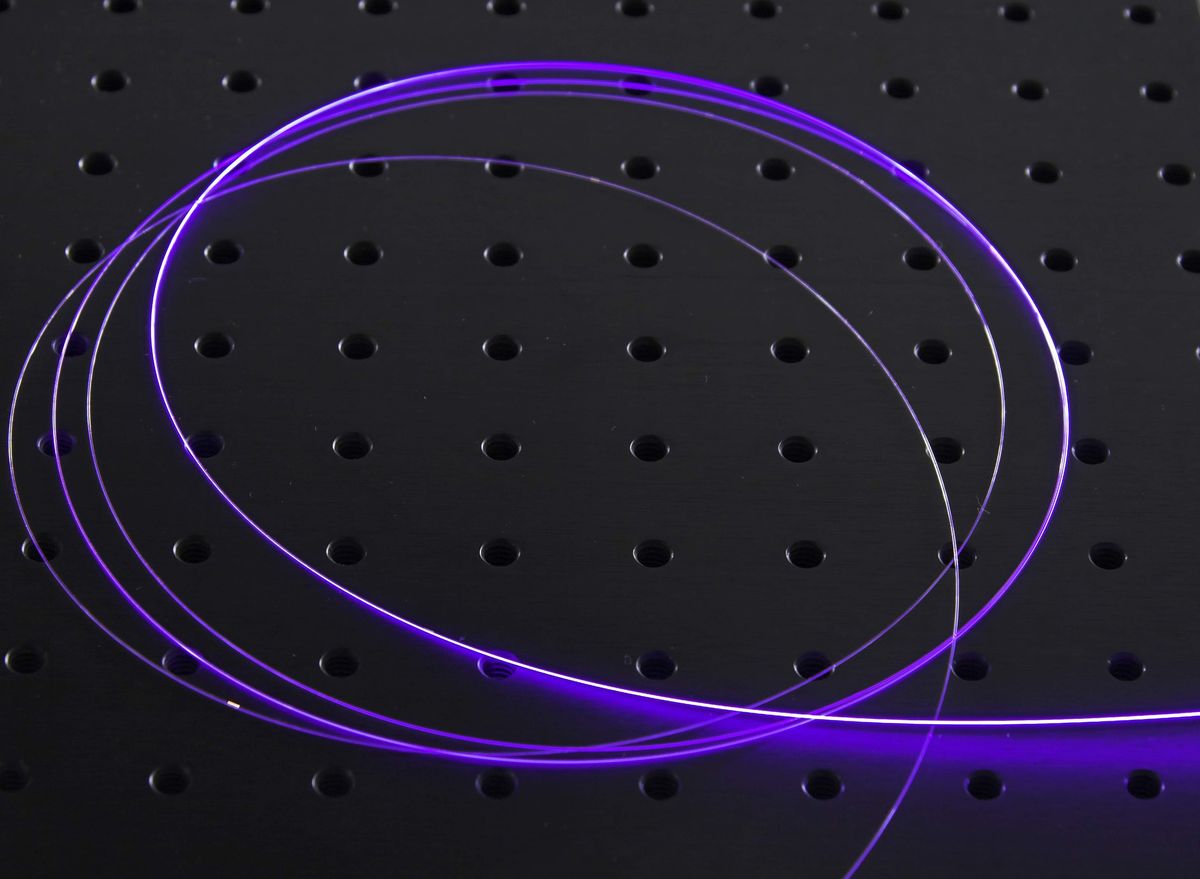Plenty of big stories from the year 1985 had their moment in the sun and are now all but forgotten: New Coke, “We Are the World,” the rise of desktop publishing. But one at-the-time obscure invention from that year has long eclipsed the frothy headlines of its time, because it comprises no small part of the communications infrastructure holding together the modern Internet. In 1985, then graduate student Robert Mears first described the erbium-doped fiber amplifier (EDFA), a device that uses the energy from a laser to amplify signals passing through a chemically modified optical fiber. The EDFA allows optical signals to cover transcontinental distances without needing to be decoded into electronic bits. It also enables the telecom carriers to pack terabits per second of signals into individual undersea optical fibers. Without it, long-distance telecommunication would be limited and expensive. Mears announced the achievement in a 1985 paper in IEEE’s Electronics Lettersjournal. (Today Mears is CTO and founder of the silicon-performance boosting company Atomera.) In an exchange with IEEE Spectrum, Mears discussed the impact of his 1985 paper and how it led to his current work, a method of chemically modifying silicon crystal growth to improve transistor function and reliability.
IEEE Spectrum: What is this paper about, and why do you think it has been so influential?
Robert Mears: The paper describes the first demonstration of optical gain in an erbium-doped optical fiber amplifier. In the paper, I demonstrated that 30-decibel optical amplification was possible at the then new telecommunications wavelength of 1.5 micrometers with a practical input laser pump power in the few milliwatts range. Today, the amplifier is known simply as an erbium-doped fiber amplifier, or EDFA.
“The [Erbium-Doped Fiber Amplifier] has transformed optical fiber transmission, enabling the broadband Internet.” —Robert Mears, CTO Atomera
Prior to the invention and demonstration of the EDFA, transatlantic telecommunications cables operated at 140 megabits per second and required submarine electronic repeaters—systems that converted the optical signals to electronic ones and back again—every few tens of kilometers. By keeping the signal optical, multiple wavelength carriers can be simultaneously amplified, increasing bandwidth by more than three orders of magnitude. Furthermore, the signals remain optical for intercontinental distances of thousands of kilometers.

The EDFA was the key to the optical Internet and enabled practical optical amplification for shorter-distance optical distribution networks and wavelength switches.
Can you describe the important problems in the field at the time that you wrote this paper, and what led you to focus on this specific research?
Mears: At the time, there was a push in the wider optical-communications industry to increase the distance an optical signal could be transmitted before requiring an electronic repeater. By moving to far infrared transmission—background attenuation from density fluctuations is much less at longer wavelengths—and by using sophisticated coherent communication techniques, it was hoped to extend the repeater spacing to around 200 kilometers, enabling repeaters to be land-based on islands rather than submarine.
Such transmission would nevertheless have been subject to the limitation of the electronic repeaters, likely a few gigahertz at most.
By contrast, nowadays, thanks to the EDFA, the signal remains optical over vast intercontinental distances of thousands of kilometers, and a single amplified fiber has a bandwidth in excess of 1 terahertz.
Did you have any idea at the time what impact this work would have on your community? How was it initially received?
Mears: A few researchers were working on other optical-amplification approaches using semiconductor amplifiers or nonlinear optics, but I realized the practical possibilities of the EDFA from 1985. In the paper, I also stressed the low-noise characteristics of the amplifier, which were key to enabling the use of multiple amplifiers over intercontinental distances. The first series of my papers was awarded the IEEE Electronics Letters prize (1986), so the potential impact of the work was immediately recognized. But, of course, people were cautious until it had been deployed in the field.
When and how was the importance of this paper ultimately recognized?
Mears: Fortunately, because of the failure of the next-generation electronic repeaters, companies like Standard Telecommunications Laboratories in Europe made the effort to iron out any potential issues, and the EDFA was successfully deployed in the transatlantic TAT-12 system in 1996, less than 10 years after my paper! In the United States, key research was done at Bell Labs to develop practical semiconductor-laser-pump sources to provide a power source for the optical amplification.
Multiple awards followed for the various teams by then involved in the global effort to deploy the EDFA.
“It is important to keep believing during the dark moments, but also to keep one’s eyes open. So often a result that at first appears insignificant can provide a hint to a much more important result, often in a slightly different area.”
—Robert Mears, CTO Atomera
How did this work affect your career, both in the short term and long term?
Mears: Well, it made writing up my Ph.D. pretty straightforward! Thanks to the papers and recognition, the invention of the EDFA helped me win a research fellowship competition to Cambridge [Pembroke College] before I had finished writing my thesis, and then a lectureship [assistant professorship] the following year.
Ten years later, I started developing ideas for reengineering silicon and looking for funding to start a semiconductor-materials and technology-licensing company. Having seen the way the EDFA transformed the optical-communications industry, I had confidence that I could make a similar impact on the semiconductor industry. My background in the invention of the EDFA helped me raise the seed capital for what became Atomera.
Looking back at this work, how do you personally view it in the present context of the field? What is important for researchers to know about it that is relevant to the field today?
Mears: The EDFA has transformed optical-fiber transmission, enabling the broadband Internet. Just as important, it also facilitated the building of optical routing switches by compensating for the optical losses incurred when splitting the signal, something I was able to go on to demonstrate at Cambridge.
But my journey to the EDFA began as an undergraduate semiconductor physicist, and my original research project was to construct and investigate an optical ring resonator [a device that acts as an optical filter] for nonlinear sensing. So, it would be wrong to think that my research was all plain sailing or that the idea of the EDFA arrived without a lot of thought and false starts. It is important to keep believing during the dark moments, but also to keep one’s eyes open. So often a result that at first appears insignificant can provide a hint to a much more important result, often in a slightly different area. For me, that is serendipity—the art of happy discovery.
What do you think the most important research questions are in your field right now?
Mears: When I left Cambridge to start Atomera, I switched my focus back to the semiconductor industry where I began my academic career. The semiconductor industry for many years had a free ride from improvements in lithography, which enabled gate-length scaling. But as we all know, the other dimensions must be scaled in tandem, and the industry has had to turn to new semiconductor and dielectric materials to enable this scaling. There is an analogy with the optical communications industry in my student days, where increasingly complex optical materials were being researched. Then, the goal was to achieve longer transmission, but now it is to achieve shorter [charge] carrier paths and higher transistor densities. The introduction of new material systems makes the semiconductor field ripe for new inventions!
To Probe Further:
The invention is described in UK Patent Applications 8520300/8520301 filed 13 August 1985, and cited as Priority documents in US Patent 4,999,025 “Fiber-optic Lasers and Amplifiers”. The inventors are listed as R.J. Mears, L. Reekie, S.B. Poole, and D.N. Payne.
A key paper was “Low-Threshold Tunable and Q-Switched Fiber Laser Operating at 1.55μm”, in Electronics Letters, 22 (3), pp. 159–160, 1986, by R.J. Mears, L. Reekie, S.B. Poole, and D.N. Payne. An important improvement appeared the following year in “Low-Noise Erbium-Doped Fiber Amplifier Operating at 1.54μm”, Electronics Letters, 23 (19), pp. 1026–1028, 1987 by R.J. Mears, L. Reekie, I.M. Jauncey, and D.N. Payne.
Samuel K. Moore is the senior editor at IEEE Spectrum in charge of semiconductors coverage. An IEEE member, he has a bachelor's degree in biomedical engineering from Brown University and a master's degree in journalism from New York University.



